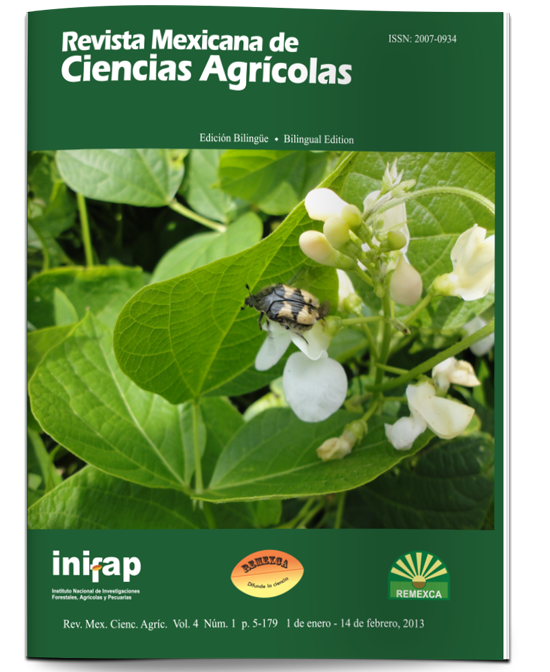Combining ability in maize with genetic divergence in the Mexican Plateau
DOI:
https://doi.org/10.29312/remexca.v4i1.1254Keywords:
Zea mays L., Chalqueño, combining ability, cross, diallelAbstract
In order to estimate the effects of the general combining ability (GCA) and the specific combining ability (SCA), 15 progenitor populations of maize race Chalqueño and 105 dialell crosses were evaluated in field under Griffing ́s design II. Sowing was done during the spring- summer season, 2006 in Zotoluca and Mixquiahuala, Hidalgo and Texcoco, State of Mexico, under a lattice experimental design 12 x 12 with three replications. Eight characteristics were analyzed, obtaining highly significant differences (p≤ 0.01) between the localities, groups and populations within groups for yielding variables (REN), grain index (GI), ears per plant (MP), ear diameter (DM ), grain length (LGR), number of rows per ear (NH), days to male f lowering (DFM) and plant height (AP). For GCA and SCA there were highly significant differences observed for the eight variables, with a greater variation in GCA than in SCA. Considering the values per se and positive effects of SCA for the evaluated variables, the populations Gto-142, Col-03-64, Col-6784, FHCH- 129Fn, Zac-66, Tlax-151 and VS-22 presented the best expression in yield, morphology and phenology; we also identified crosses with high SCA effects for REN, IG, MP, DM, LGR NHM, DFM and AP. Based on the reported effects, outstanding populations were detected, highlighted by their genetic potential of Chalqueño race, resulting in significant interactions between the parent populations from different geographic origins and outstanding heterotic patterns considered feasible for maize breeding programs maize.
Downloads
Downloads
Published
How to Cite
Issue
Section
License
The authors who publish in Revista Mexicana de Ciencias Agrícolas accept the following conditions:
In accordance with copyright laws, Revista Mexicana de Ciencias Agrícolas recognizes and respects the authors’ moral right and ownership of property rights which will be transferred to the journal for dissemination in open access. Invariably, all the authors have to sign a letter of transfer of property rights and of originality of the article to Instituto Nacional de Investigaciones Forestales, Agrícolas y Pecuarias (INIFAP) [National Institute of Forestry, Agricultural and Livestock Research]. The author(s) must pay a fee for the reception of articles before proceeding to editorial review.
All the texts published by Revista Mexicana de Ciencias Agrícolas —with no exception— are distributed under a Creative Commons License Attribution-NonCommercial 4.0 International (CC BY-NC 4.0), which allows third parties to use the publication as long as the work’s authorship and its first publication in this journal are mentioned.
The author(s) can enter into independent and additional contractual agreements for the nonexclusive distribution of the version of the article published in Revista Mexicana de Ciencias Agrícolas (for example include it into an institutional repository or publish it in a book) as long as it is clearly and explicitly indicated that the work was published for the first time in Revista Mexicana de Ciencias Agrícolas.
For all the above, the authors shall send the Letter-transfer of Property Rights for the first publication duly filled in and signed by the author(s). This form must be sent as a PDF file to: revista_atm@yahoo.com.mx; cienciasagricola@inifap.gob.mx; remexca2017@gmail.
This work is licensed under a Creative Commons Attribution-Noncommercial 4.0 International license.



